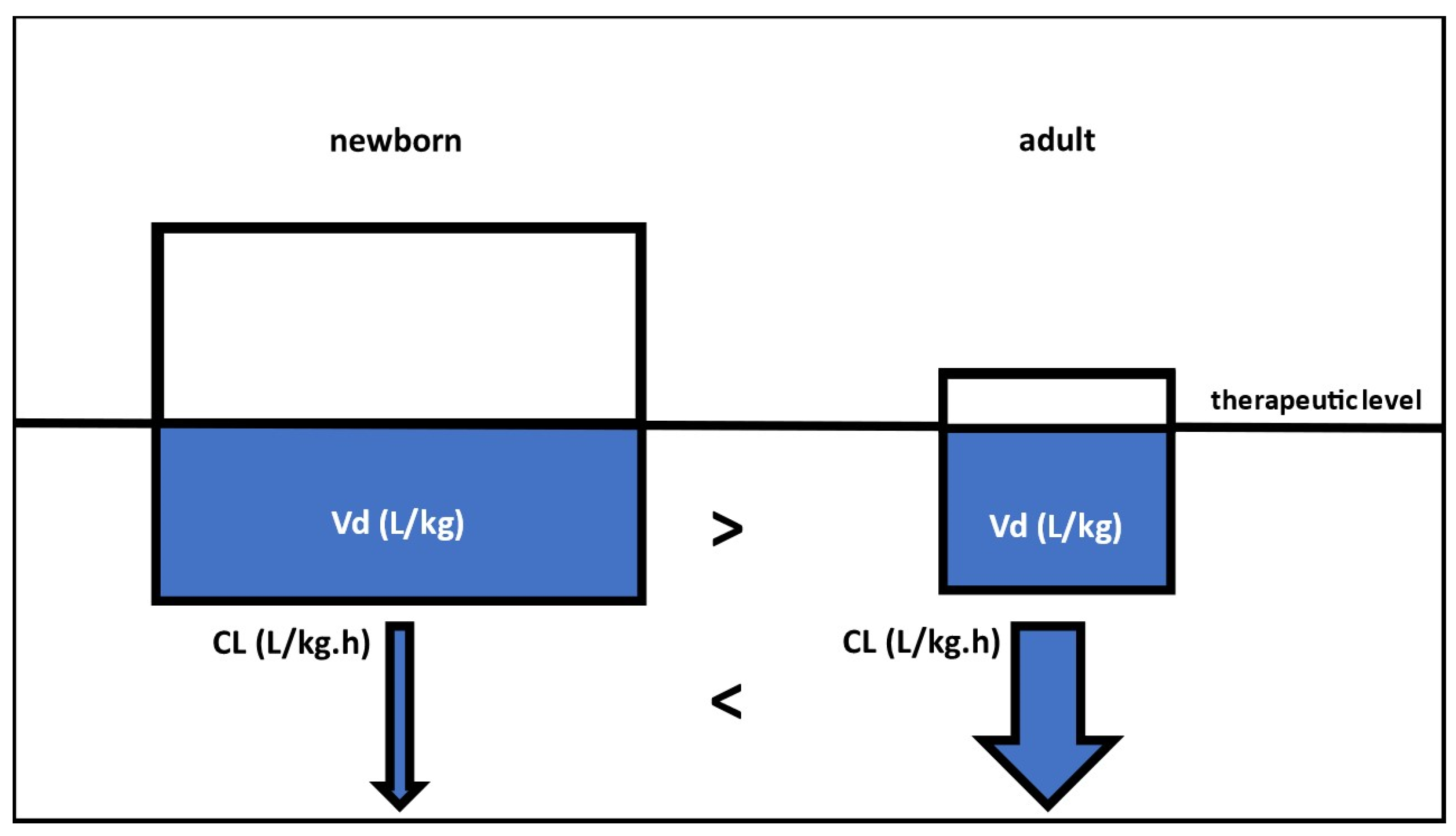Interdisciplinary Collaboration on Real World Data to Close the Knowledge Gap: A Reflection on “De Sutter et al. Predicting Volume of Distribution in Neonates: Performance of Physiologically Based Pharmacokinetic Modelling”
Abstract
:Author Contributions
Funding
Institutional Review Board Statement
Informed Consent Statement
Data Availability Statement
Conflicts of Interest
References
- De Sutter, P.J.; Rossignol, P.; Breens, L.; Gasthuys, E.; Vermeulen, A. Predicting Volume of Distribution in Neonates: Performance of Physiologically Based Pharmacokinetic Modelling. Pharmaceutics 2023, 15, 2348. [Google Scholar] [CrossRef] [PubMed]
- Allegaert, K.; van den Anker, J. Neonatal drug therapy: The first frontier of therapeutics for children. Clin. Pharmacol. Ther. 2015, 98, 288–297. [Google Scholar] [CrossRef] [PubMed]
- Abduljalil, K.; Pan, X.; Pansari, A.; Jamei, M.; Johnson, T.N. A preterm physiologically based pharmacokinetic model. Part I: Physiological parameters and model building. Clin. Pharmacokinet. 2020, 59, 485–500. [Google Scholar] [CrossRef] [PubMed]
- Kimko, H.; Lee, K. Improving realism in clinical trial simulations via Real-World data. CPT Pharmacomet. Syst. Pharmacol. 2017, 6, 727–729. [Google Scholar] [CrossRef] [PubMed]
- Keles, E.; Wintermark, P.; Groenendaal, F.; Borloo, N.; Smits, A.; Laenen, A.; Mekahli, D.; Annaert, P.; Şahin, S.; Öncel, M.Y.; et al. Serum creatinine patterns in neonates treated with therapeutic hypothermia for neonatal encephalopathy. Neonatology 2022, 119, 686–694. [Google Scholar] [CrossRef] [PubMed]
- Studiecentrum Voor Perinatale Epidemiologie. Available online: https://zeg.paddlecms.net/sites/default/files/2023-11/SPE-Perinatale%20gezondheid%20in%20Vlaanderen%202022_FINAL.pdf (accessed on 24 November 2023).
- Leys, K.; Stroe, M.S.; Annaert, P.; van Cruchten, S.; Carpentier, S.; Allegaert, K.; Smits, A. Pharmacokinetics during therapeutic hypothermia in neonates: From pathophysiology to translational knowledge and physiologically-based pharmacokinetic (PBPK) modeling. Expert Opin. Drug Metab. Toxicol. 2023, 19, 461–477. [Google Scholar] [CrossRef] [PubMed]
- Lingvall, M.; Reith, D.; Broadbent, R. The effect of sepsis upon gentamicin pharmacokinetics in neonates. Br. J. Clin. Pharmacol. 2005, 59, 54–61. [Google Scholar] [CrossRef] [PubMed]
- Cooper-Peel, C.; Brodersen, R.; Robertson, A. Does ibuprofen affect bilirubin-albumin binding in newborn infant serum? Pharmacol. Toxicol. 1996, 79, 297–299. [Google Scholar] [CrossRef] [PubMed]
- Van Neste, M.; Bogaerts, A.; Nauwelaerts, N.; Macente, J.; Smits, A.; Annaert, P.; Allegaert, K. Challenges Related to Acquisition of Physiological Data for Physiologically Based Pharmacokinetic (PBPK) Models in Postpartum, Lactating Women and Breastfed Infants—A Contribution from the ConcePTION Project. Pharmaceutics 2023, 15, 2618. [Google Scholar] [CrossRef] [PubMed]
- Johnson, T.N.; Small, B.G.; Yeo, K. Increasing application of pediatric physiologically based pharmacokinetic models across academic and industry organizations. CPT Pharmacomet. Syst. Pharmacol. 2022, 11, 373–383. [Google Scholar] [CrossRef] [PubMed]

Disclaimer/Publisher’s Note: The statements, opinions and data contained in all publications are solely those of the individual author(s) and contributor(s) and not of MDPI and/or the editor(s). MDPI and/or the editor(s) disclaim responsibility for any injury to people or property resulting from any ideas, methods, instructions or products referred to in the content. |
© 2024 by the authors. Licensee MDPI, Basel, Switzerland. This article is an open access article distributed under the terms and conditions of the Creative Commons Attribution (CC BY) license (https://creativecommons.org/licenses/by/4.0/).
Share and Cite
Allegaert, K.; Smits, A.; Annaert, P. Interdisciplinary Collaboration on Real World Data to Close the Knowledge Gap: A Reflection on “De Sutter et al. Predicting Volume of Distribution in Neonates: Performance of Physiologically Based Pharmacokinetic Modelling”. Pharmaceutics 2024, 16, 128. https://doi.org/10.3390/pharmaceutics16010128
Allegaert K, Smits A, Annaert P. Interdisciplinary Collaboration on Real World Data to Close the Knowledge Gap: A Reflection on “De Sutter et al. Predicting Volume of Distribution in Neonates: Performance of Physiologically Based Pharmacokinetic Modelling”. Pharmaceutics. 2024; 16(1):128. https://doi.org/10.3390/pharmaceutics16010128
Chicago/Turabian StyleAllegaert, Karel, Anne Smits, and Pieter Annaert. 2024. "Interdisciplinary Collaboration on Real World Data to Close the Knowledge Gap: A Reflection on “De Sutter et al. Predicting Volume of Distribution in Neonates: Performance of Physiologically Based Pharmacokinetic Modelling”" Pharmaceutics 16, no. 1: 128. https://doi.org/10.3390/pharmaceutics16010128





